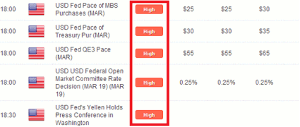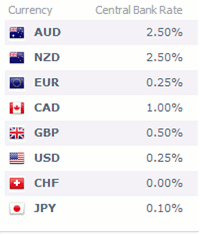Most major economies around the globe have central banks whose monetary policies affect their currencies, which is why it's important for fundamental traders to keep an eye on the economic calendar, says Walker England of DailyFX.com.
Fundamental traders keep a watchful eye on central banks and the policy decisions they make. These intuitions, through changes in monetary policy, not only can affect an underlying economy but by de facto currency rates as well. Today, we will continue our look at market fundamentals by examining central banks and how their policy decisions can affect forex prices. Let's get started!
Central Banks
Central banks are institutions used by nations around the globe to assist in managing their country or region with the commercial banking industry, interest rates, and currency prices. Examples of active central banks include the Federal Reserve of the United States, European Central Bank (ECB), Bank of England (BOE), Bank of Canada, and the Reserve Bank of Australia (RBA). The sphere of influence of a central bank may range from a single country such as the Reserve Bank of Australia or, represent policy created for a region or group of countries such as the ECB. Because of this, the actions of central banks have the ability to move markets and should be on every fundamental trader's radar.
Central Banking Rates
Monetary Policy
Normally, a central bank will use the monetary tools at their disposal to meet their designated goals. Monetary policy describes the actions taken by a central bank to control the money supply inside of its designated region. Depending on the state of the economy, the Fed may select to either take an expansionary or contractionary policy, with the supply of money being influenced by two specific methods.
During times of crisis or economic slowdown, central banks will normally look to expand their monetary policy. They can do this by expanding asset purchases which increases the monetary base and by also decreasing interest rates. The theory behind monetary expansionary is to make money available to banks and businesses in an attempt to increase growth and development. As a byproduct of an expansionary policy, fundamental indicators such as GDP are expected to grow and unemployment decline.
As the economy heats up, the Fed will consider taking on contractionary measures. At this point, the monetary base may begin to be restricted and interest rates can begin to increase. These actions make excess investment capital scarce, and place a higher premium on lending. With less capital circulating, the economy is expected to contract and slow down. During a time of contraction, GDP is expected to decline and unemployment to contrarily increase.
Fed Events for March 2014

(Created using FXCM's Marketscope charts)
Click to Enlarge
Central Banks and Forex
By controlling the money supply and interest rates, the decisions mandated by the Federal Reserve can change currency prices. If a Central bank begins a series of contractionary policies, this may increase the price of that banks underlying currency. As money and lending is tightened demand for currency will increase. When this is coupled with a lower supply of currency and increased lending requirements this can drastically increase prices.
Conversely, when central banks loosen monetary policy, this can cause a depreciation of their currency. Lower interest rates can cause lending to increase at lower prices, as well expanding central bank balance sheets, which can create an excess supply of a currency. With a new larger supply of a currency, and with demand being low, this can cause prices to drop.
Policy Decisions
Policy decisions and economic releases from Central Banks will occur sporadically throughout the month. The best way to track upcoming news is through the use of a good economic calendar. As these decisions are made, it is also important to track the movements of the market! You can check out the latest movements in the Forex market by registering for a free forex demo account. This way you can become comfortable with the market and the effects of central banks on prices in real time!
This will conclude the third installment of our forex guide to fundamentals series. If you missed one of the previous editions, please enjoy the articles here and here.
By Walker England, Trading Instructor, DailyFX.com






















